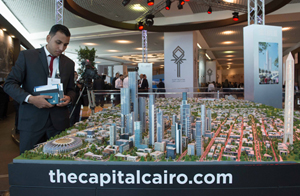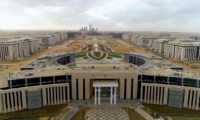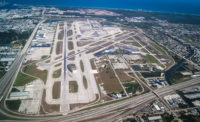
Egypt says it plans to build a new government and financial capital district near Cairo that could take $45 billion and more than seven years to construct. The new “city” would accommodate roughly 7 million residents, Egyptian housing minister Mostafa Madbouly said at an economic development conference held in Sharm El Sheikh in March.
Plans call for the Capital Cairo project—to be located east of Cairo, near the Red Sea—to host government offices, including parliament, a presidential palace, foreign embassies and other state-department offices. Madbouly said the city will occupy approximately 700 square kilometers, and will feature an international airport, 90 sq km of solar farms and a rail link to historic Cairo. Early plans also include 2000 schools and colleges and 600 health-care facilities. Officials did not provide specific construction cost estimates and schedules.
According to the project’s designer, Chicago-based Skidmore, Owings and Merrill LLP (SOM), "The master plan is to create a global city with smart infrastructure for Egypt’s future."
"While we are at the earliest stages of design, the new city will be built on core principles that include places of education, economic opportunity, and quality of life for Egypt’s youthful population," Philip Enquist, a SOM partner, said via a press statement.
"The new city will be designed and built in harmony with nature as a showcase of environmentally sensitive development,” Enquist added. The company did not respond to ENR’s email request for an interview.
Dubai-based Capital City Partners Ltd, a private real-estate investment fund, is expected to facilitate financing for the ambitious project, which was one of 50 projects—worth a collective $70 billion—that were presented during the March economic conference.
"It is a natural extension for the city of Cairo," Emirati Mohamed Alabbar, with Capital City Partners, told the BBC in March. "It is a wonderful opportunity to be able to design something from scratch, and to design it keeping in mind the needs of the Egyptian people and the Egyptian government."
If it moves forward, the project will boost Egypt's construction sector, which currently accounts for 8% of the nation’s total employment. The country’s construction spending has been predicted to increase to $7.3 billion in 2015, from $5 billion in 2009, according to a market overview by Thailand’s Dept. of International Trade Promotion (DITP) trade center in Cairo.
However, the DITP says: “Egypt is a high-risk country because of high bureaucracy and corruption levels, low income, rising unemployment and continued security threats. … However, the government is taking initiatives to relax regulations for private investment to attract foreign investors and to improve the business environment. This will lead to the growth of business units, thereby encouraging more construction activity to match the growing infrastructural demands."
Although the ambitious project drew criticism from those who think funding should be used instead to improve living standards in Cairo and other urban areas, SOM City Design Practice Director Daniel Ringelstein says the project “complements the national vision for an Egyptian renaissance."
Lebanon’s largest bank, Bank Audi Group, recently warned that Egypt needs to create an environment that encourages long-term planning and investment, and reduces risk, in order to realize its full potential in the infrastructure and construction sector.
The bank said Egypt’s most significant hurdle to future development "is the possibility of private investment drying up in the face of heightened political risk.”



Post a comment to this article
Report Abusive Comment